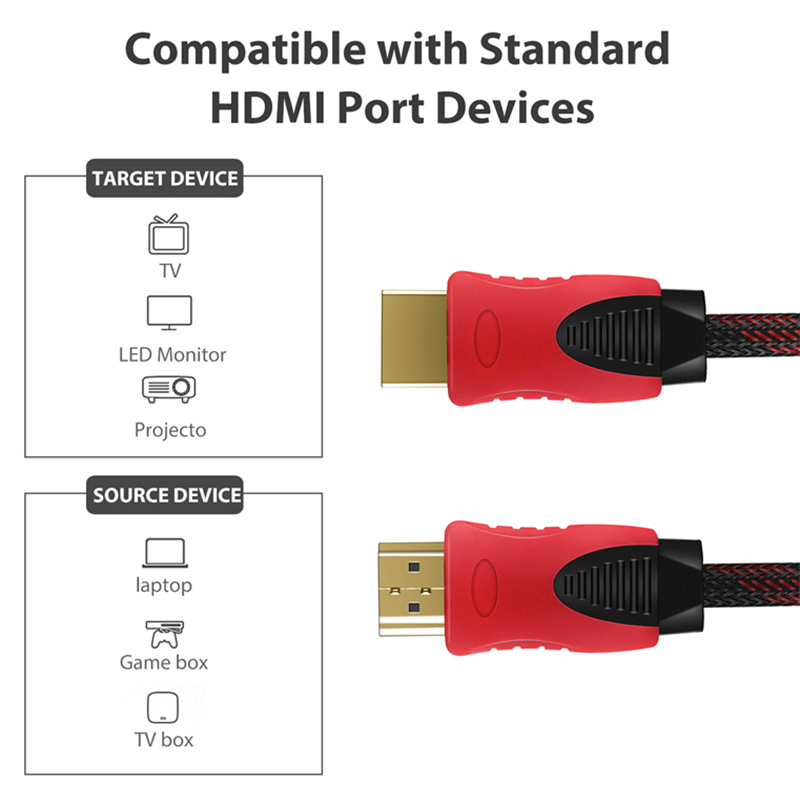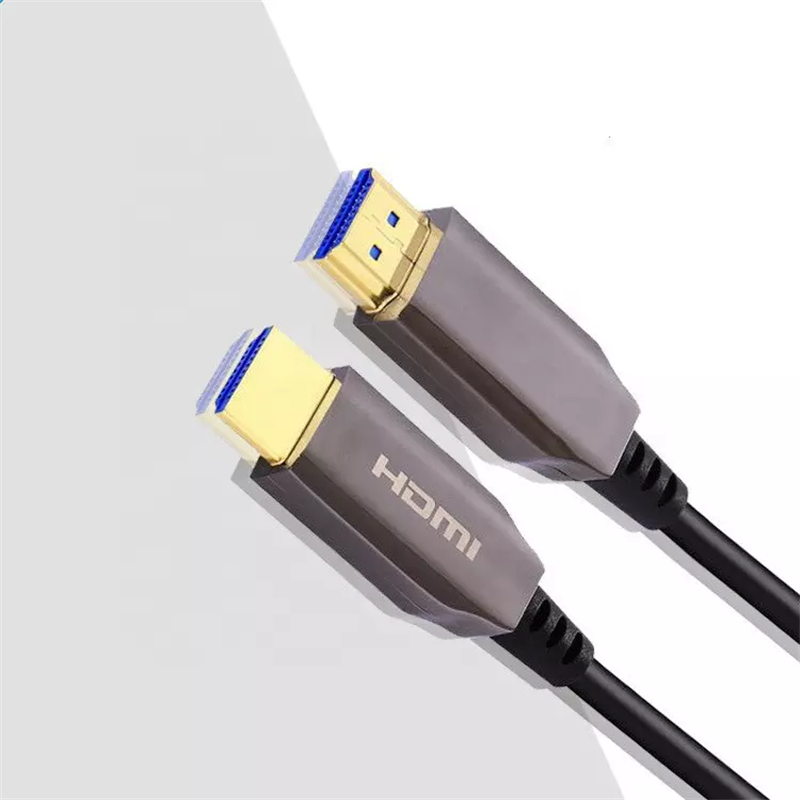When you purchase through links in our articles, we may earn a small commission. This doesn't affect our editorial independence.
If you’ve just bought a new 4K TV, you might be wondering if you need to buy a new HDMI cable to go with it. If you already have an HDMI cable, the quick answer is: Probably not. Chargers

We’ll explain why in detail shortly. First, we’ll explain the four basic types of HDMI cables and offer our purchase recommendations for each category if you don’t already have a cable or if you need to replace a damaged cable.
An HDMI cable is just a conduit between your TV and media device, be it a DVD, Blu-ray, or 4K UHD Blu-ray player; media streamer; video game console; or PC. Different types of HDMI cables do exist, but their designations indicate how much data they can carry. (Spoiler: There’s really no such thing as a 4K HDMI cable.)
When pared down to the most basic information, the video resolution guidelines—as set by the HDMI Forum Technical Working Group that defines the specification—are:
The more detailed versions of the guidelines matter if you want more than just a basic TV signal: If you play video games at more than 30 frames per second, for example, or you intend to make full use of an HDR TV, or you want an HDMI cable that can also carry data over ethernet (most people do not, but that bandwidth can be used for other things).
For these types of scenarios, you must take refresh rate (measured in cycles per second, stated as Hertz, and abbreviated as Hz), the level of color precision (aka color depth, measured in bits; e.g., 8-bit, 10-bit, or 12-bit), and color data compression (i.e., chroma subsampling) into consideration.
The higher you go with refresh rate and bit depth—and the less color data compression you opt for—the more data that will be pushed to your TV.
If you attach a gaming PC capable of gaming at 4K/60fps to your TV, you’ll need an HDMI cable that can handle that level of data transmission.
Accordingly, you’ll need an HDMI cable that has adequate bandwidth. A Premium High Speed HDMI cable should cover the highest demands you’d ask of a 4K TV with a 60Hz refresh rate.
If you bought a 4K TV with a true 120Hz refresh rate, like for use with a PlayStation or Xbox, you should move up to an Ultra High Speed HDMI cable.
Right-click to open this chart in a new tab. This information from the HDMI Licensing Administrator will help you determine which HDMI cable is appropriate for your needs. Any of the higher standards will of course work with any lower-resolution video signal, but they won’t make lower-resolution video look any better.
The HDMI cable that you already have might support all the features you need. Here’s how to figure that out.
Just connect your TV and media device using your existing cable. If you get a steady image with no artifacts, you’re good to go. No additional thinking is required.
You can determine if your existing cable is adequate in one of two ways.
Of the two methods, the second is a little more reliable—typically, you’ll immediately get a signal (or you won’t). But it’s usually best to start with method one first and then try method two. If you end up with a blank screen during method two, switching back to viewable settings can be a hassle depending on your device.
Only want to watch Netflix shows (such as The Crown) in 4K and nothing more? If the HDMI cable you’re using now provides a steady picture, you’re all set.
If the HDMI cable(s) you have on hand can’t meet your requirements—say, playing 4K content at 120Hz or with HDR—then you’ll need to shell out for a new one. You can also buy a new cable if you want to ensure compliance with a particular HDMI spec. For example, Ultra High Speed HDMI cables must be certified to earn the label, and should thus have guaranteed compatiblity with HDMI 2.1 devices like the PlayStation 5 and Xbox Series X.
If you’ve hung your TV on the wall and now want to run your cables inside the wall to keep them out of sight, you likely won’t be able to use an HDMI cable already on-hand. Professional installers use in-wall-rated HDMI cables for this purpose, and so should you if you’re doing the work yourself. In-wall-rated cables are made to resist fire (like during a power surge or if something nearby is burning) and not give off toxic smoke if they do burn.
For such cables, look for one of two National Electric Code (NEC) certifications: either Class 2 or Class 3 (abbreviated as CL2 and CL3). The difference is in the maximum voltage that each must accept: CL2 must accept up to 150 volts, while CL3 must accept up to 300 volts. In both cases, the cable’s jacket will also be thicker and better insulated to protect the wires inside as the cable is pulled through the wall and bent inside tight spaces, such as a junction box. Either certification is sufficient for HDMI signals. In-wall rating should not add a significant amount to the price of the cable.
If your source device is at one end of the room and your display is at the other (such as a video projector and its screen), or if your source and display are in different rooms, you might need a cable with a built-in signal amplifier to ensure the data can be transmitted from one end to the other. You’ll commonly find these cables classified as “active” HDMI cables (preface each of the cable types we’ve already discussed with “active”). Another solution for long cable runs is an HDMI signal booster, such as the Key Digital KD-HDFIX22.
That doesn’t mean you need to pay $30 or more for a cable (though active cables do cost more). The price of the cable doesn’t necessarily ensure performance. Rather, its classification and its certification do.
You can buy a very inexpensive cable and still get top-notch performance. Our recommendation is to pick from among Monoprice or AmazonBasics options, which have huge followings for their affordability and reliability. (See the sidebar for specific suggestions.) Active and/or exotic cables (e.g., cables that use fiber optic strands instead of copper wires) for very specialized installations will cost more, but they don’t perform better than their more plebeian counterparts in typical installations and transmission distances.
If you don’t know which exact cable to get, or you’d like to peruse available options on your own, be sure to consider the following:
We can’t stress this enough, and it applies across the board—including in-wall-rated cables.
Certified Premium High Speed HDMI cables have passed additional testing in order to sport the label. (You’ll find more information about HDMI certification and how to verify authenticity at the preceding link.)
But you don’t need to pay a big markup to get that peace of mind: Monoprice, for example, sells two different 6-foot Certified Premium HDMI cables for less than $10 each. And you can buy a 15-foot, CL3-rated high-speed AmazonBasics HDMI cable for $13.
These cables are extremely overpriced. There’s no need to spend that much on any passive HDMI cable, including in-wall-rated cables such as these.
If you look on Amazon or Monoprice.com, you’ll sometimes see products with names like “Ultra Slim High Speed Cable.” If you’re not paying close attention, you might not realize this particular example is just a high-speed cable: The “ultra” in this case refers to how thin the cord is, not the speed at which it’s capable of carrying data.
Ensure you get the right cable by looking at the actual specs. The quickest way to determine the type is to look for its bandwidth rating.
You won’t find a respectable Ultra High Speed HDMI cable for $3, but you can find a good High Speed cable at that price, although it might be limited to a lower refresh rate. (Then again, true High Speed cables are far less common.)
By paying attention to bandwidth rating, refresh rate, and price, you can avoid unreliable cables. Options outside of the better-known inexpensive brands (AmazonBasics and Monoprice are currently the top two) can be tempting, but some budget cables have weak electromagnetic interference (EMI) shielding, which can disrupt your Wi-Fi network, and they might cause visual artifacts and signal drop-outs. If you see a two-pack of High Speed HDMI cables for the same price as a single Monoprice or AmazonBasics option, proceed with caution.
On the flip side, bandwidth rating and price can also help you discover cables that punch above their weight, such as the AmazonBasics High Speed HDMI cable. It’s not certified as a Premium High Speed cable, but the manufacturer promises it can deliver that much bandwidth (18Gbps). Unsurprisingly, it’s also priced higher than a typical budget 6-foot High Speed HDMI cable.
Active HDMI cables should not cost exorbitantly more than their passive counterparts. While prices do go up, you can find them for well below the usurious rates of highly marketed cables at Best Buy and similar stores. On Monoprice, for example, a 6-foot 4K Slim High Speed HDMI cable costs less than $9; its active counterpart is priced at $28.
The longer the distance that a signal needs to go, the more likely that parts of that signal won’t reach its destination without amplification (e.g., an active cable or a signal amplifier box).
The general rule of thumb is that for lengths of six feet or less, a passive cable is more than adequate. Between six and about 25 feet is negotiable, and above that, most people will opt for an active cable or a signal amplifier.
Active HDMI cables includes a signal booster to prevent artifacts and drop-outs over long distances.
The receiving chip in your TV can also influence whether or not a passive cable will work over long distances—if it’s better at adjusting for a weaker signal, you won’t need the signal boost.
Gold-plated connectors make a marginal difference with analog signals, because the connections don’t oxidize, but they don’t matter at all with the digital signals an HDMI cable carries. If you care about a solid picture, you only need to pay attention to a cable’s speed rating and length, and whether it’s passive or active. That’s it.
If you’ve heard of HDMI specifications (e.g., HDMI 1.3, HDMI 1.4, HDMI 2.0, and HDMI 2.1), you might wonder how HDMI cables relate to them.
As mentioned above, an HDMI cable is just a conduit for data to travel along. You can think of it like a pathway: Choose a wider one (i.e., higher bandwidth) if you have more data that must march along it at the same time.
HDMI specifications outline what kinds of features are allowed to travel along that path: resolution, color depth, types of chroma subsampling, and more. With each new specification, each new feature has increased HDMI’s bandwidth requirement.
We go into more detail on the latest HDMI specifications in our HDMI 2.0 and HDMI 2.1 primers, but all you really need to know is which features your hardware supports and which features you intend to take advantage of. Once you’ve narrowed that down, you’ll know which type of HDMI cable you need.
Our colleagues over at Tech Advisor have also reviewed the best HDMI cables.
Sign up for the weekly Best of TechHive newsletter

Mini Usb Cable Alaina Yee is PCWorld's resident bargain hunter—when she's not covering software, PC building, and more, she's scouring for the best tech deals. Previously her work has appeared in PC Gamer, IGN, Maximum PC, and Official Xbox Magazine. You can find her on Twitter at @morphingball.